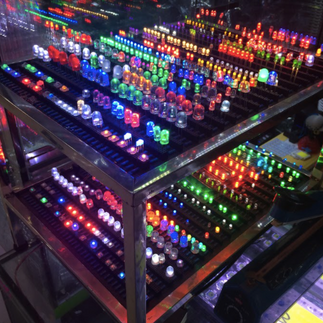Huaqiangbei: Shezhen’s electronic markets
- chloeagarnham
- May 6, 2021
- 3 min read
Updated: Feb 20, 2023
Shenzhen is known globally as the hub of electronics. Unsurprisingly Shenzhen’s flourishing ecosystem is a breeding ground for tech. Giants like Huawei, ZTE, and Tencent were born locally, and the city’s famous innovation area, Nanshan, is home to 156 listed companies.
What separates the city as a world leader is its uniqueness: it contains every essential element required for electronic production. But it’s not just electronics factories that have led to Shenzhen being dubbed, ‘China’s Silicon Valley’. Shenzhen is world-renowned for being home to Huaqiangbei––the largest electronic markets in the world.

The markets cover an incredible 21 million square meters, contain millions of stalls, and represent a number of manufacturing firms in Shenzhen. For makers, touring Huaqiangbei is a dream-come-true. It wasn’t surprising that after long days of touring factories, the HardworX 2017 tour group of engineers, entrepreneurs, and startup founders were thrilled to spend hours exploring the area.
Every essential element
The electronic markets contain every type of electronic item the mind can conceive. Electronics from resistors and diodes, right through to sophisticated robots are available at the markets. There are components, modules, finished goods, and repair services. There are even floors dedicated to LED lights alone, electromagnets, switches, hoverboards, motherboards for iPhones, and test jigs.
Take SEG Electronic Market for example, which consists of ten floors filled with PCs, laptops, GPS, and other gadgets. Or Huaqiang Electronic World which has a rich supply of tools, chips, LED, and cables. Manhar Digital Plaza, on the other hand, focuses on retail mobile phones, and drone stores.
For the entrepreneur, the markets are a dream-come-true. With every component available, visiting the markets means finding exactly what’s required for an at-home project, prototyping, or even for advanced consumer products.
The inexpensive prices and variety available enables innovators to source the precise components they needed to further their innovation.
Importantly, though, for the Shenzhen ecosystem, the markets mean that electronic innovation is, arguably, the most advanced in the world. In fact, the markets are a key to Shenzhen’s success as a manufacturer ecosystem in that every essential element for innovation exists there. The markets form an essential part of Shenzhen’s core offering.
Three tips for visiting the markets
Visiting the markets, for the uninitiated can be overwhelming. That’s why a little planning can mean a more productive and awe-inspiring visit.

Be specific
For those visiting, it’s important to note the scale of the markets. Huaqiangbei runs kilometers long, up into skyrise towers, with wall-to-wall electronics. The area is so big and complex, that it’s essential to plan specific areas to visit that fulfill a wish list.
Researching which market sells the precise electronics one is looking for can help immensely when visiting.
Allow time
It’s also essential to allow plenty of time to truly explore and appreciate the area. The 2017 Shenzhen tour group was at times overwhelmed by the scale of the markets––and the most common piece of feedback was: they wanted more time.
Exploring Huaqiangbei in-depth, can take a few days, not only comprehend the scale and begin discovering what you came looking for, but also to compare prices between vendors, discuss custom design options, or in some cases, even place orders as many of the stalls in Huaqiangbei are representatives of factories.
Be open-minded
While you may visit the markets with a particular wishlist in mind––the markets are likely to broaden your horizons. With Shenzhen being the electronics epicentre of the world: access to components is unparalleled. Expect to see things in the markets that you’ve never seen before. Allow your creative juices to flow. Perhaps there are components there you never knew you needed.
At the same time, be wary of what you’re purchasing and from whom. Stallholders are not vetted, so it’s a case of buyer beware. Counterfeit products and components are in abundance, so make sure to test before you buy. Just because the price is good, or you’ve not seen the component before, doesn’t mean it’s fake: it simply means you should satisfy yourself that what you are paying for is fit for purpose.
Learn more about the tour groups journey through Shenzhen's electronic markets.
HardworX would like to thank all those who made the tour possible, and in particular:
Karl von Möller for his passion and dedication in producing this documentary series. The entire documentary episode list can be viewed here.
All of the factories for welcoming the tour group, spending time, and sharing knowledge. To view a list of the factories visited, click here.
The HardworX Shenzhen Innovation 2017 tour group consisted of tour leader Vela Georgiev, participants Andy Gelme, Brian Gilbert, Jon Oxer, Kemal Ajay, Liam Brennan, Noor Magesh, Sarah Last, Tom Partridge, Simon Holmes a Court, Hans Chang, and Karl von Möller.






















Comments